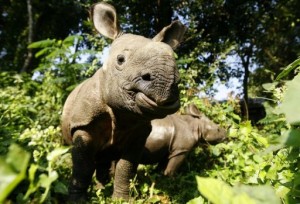Rhinos and Tigers and…Oh Wait, Let’s Limit Their Numbers
Feb 4th, 2013 | By admin | Category: Biodiversity/ConservationBy Suzanne York, www.howmany.org
A recent story on BBC News epitomizes some of the challenges for balancing conservation efforts and the needs of people.
The news article of note addressed wildlife, endangered species, development, and population growth in Nepal. Titled Attacks Prompt Nepal to Cap Wildlife Growth, the BBC reports that “Officials in Nepal have said they will now have to put a cap on the growth of wildlife including endangered species like tigers and rhinos.”
Yes, it actually says that a cap on wildlife is needed. In a world where endless growth is held up as the standard to attain, it turns out that this doesn’t apply so much to nature.
According to Krishna Acharya, spokesperson for Nepal’s Forest Ministry, “The number of rhinos and tigers are increasing in the national park and they are moving out in search of food and space. Meanwhile, the increasing human population needs more of the natural resources available, and that competition creates conflict.”
Unsurprisingly, wild animals don’t respect human boundaries and may feel compelled by instinct to migrate. Conservationists underscore the importance of creating wildlife corridors in addition to protected areas, for species that need to roam.
In the late 1960s, an estimated 65 Indian rhinos survived in Nepal, but due to increased conservation efforts, the total population was up to 534 in 2011, according to data from World Wildlife Fund.
However, despite that success, many scientists believe the Earth is undergoing its sixth mass extinction. For example, the Bengal tiger is close to being poached and encroached out of existence. In 2000, Nepal was home to over 350 tigers, but by 2008 numbers plunged to 121.
Every effort should be made to protect all wildlife. Human encroachment all over the planet has wiped out an unknown number of species since the dawn of man. That doesn’t mean that it’s okay to have leopards running around attacking children or elephants rampaging villages. Yet somehow, a balance must be found between people and nature.
There are a few ways to attain that that balance – by investing in rights-based approaches and conservation efforts that involve local people.
Women’s Empowerment
Empowering women and girls is a big factor in protecting the environment. A woman’s right to decide when and whether to have a child, and her access to reproductive care, are key components of a healthy and sustainable society.
Women are on the front lines of coping with environmental degradation. In most countries around they world they are the main providers of food, water, and other resources for their families. When women are empowered, they can better support their families and adapt to environmental impacts.
In Nepal, the total fertility rate (average number of children born to a woman during her lifetime), currently at 2.6, has been declining. In terms of contraceptive use among married women ages 15-49, forty-three percent use some modern method of birth control (compared to the world average of fifty-six percent).
A United Nations Population Fund report found “issues of equity in access to resources (e.g.,land, water, forest, etc.) and women’s meaningful participation in resource conservation and management, land development and infrastructure projects have not been addressed effectively so far.”
The country is also not doing enough to eradicate poverty. Seventy-eight percent of the population lives on less than $2 a day. Bringing women out of grinding poverty and reducing gender inequality should be a priority.
Rights of Nature
There is a growing movement around recognizing rights of nature. Rather than treating nature as property under the law (as women and slaves once were), rights of nature acknowledges that nature in all its life forms has the right to exist, persist, maintain and regenerate its vital cycles. Rights of nature laws eliminate the authority of a property owner to interfere with the functioning of ecosystems and natural communities that exist and depend upon that property for their existence and flourishing.
It is seeing the natural world as something other than a resource for human exploitation, and that humans are part of nature, not separate. It may be a difficult concept for some to acknowledge, but humans depend too much upon the ecosystem to not consider how we disrupt it to the detriment of others, and ourselves.
Acharya, of the Forestry Ministry, “hinted” that his country will now not commit to protect more wildlife than the amount its protected areas could sustain. Comments such as this reflect the urgency to find ways to value and respect the web of life.
Continued Conservation Efforts
The International Union for Conservation of Nature (IUCN), like most conservation organizations (and governments), wants to involve locals in conservation efforts, which can provide livelihoods and income. In turn, people become invested in preserving their local environment and culture. It is also important to implement education and awareness programs for both tourists and the local community.
The IUCN also states how critical it is to reduce human-wildlife conflicts, and suggest this might involve fencing. Yet there have been few studies on its effectiveness. One study on elephants and electric fences found that “electrified fences can alleviate human-elephant conflict when well maintained and vigorously enforced.” However, it also found the cost of constructing, maintaining and enforcing is high and that “this approach may only be applicable in well-resourced conservation areas.” Given Nepal’s conservation successes, it seems fencing might be worth undertaking.
Future Outlook
Nepal has made great strides in protecting its wildlife. Yet instead of celebrating this fact, wild species appear to be more of a burden than benefit. In a country slightly larger than Arkansas, with a population of 30 million, there will continue to be challenges between humans and nature.
Nepal is not alone in striving to meet the needs of its people and wildlife. Only by educating and empowering people, and respecting rights for all – wherever we live – can we hope to live sustainably and in harmony with the natural world with which we share the planet.
Suzanne York is a senior writer with the Institute for Population Studies
[Rhino photo: http://phys.org/news/2011-04-nepal-rhino-recovering-war.html]
[Tiger photo credit: http://www.geekosystem.com/tigers-night-shift/]


